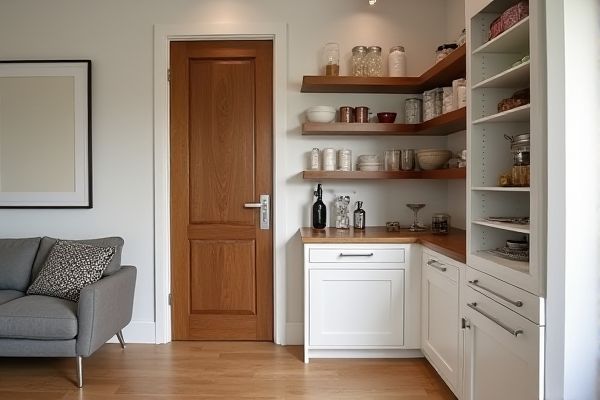
A walk-in pantry offers ample space for organizing bulk items and easy access to groceries, enhancing kitchen efficiency, while a cabinet pantry maximizes compact areas with built-in shelves suited for smaller kitchens. Discover which pantry style best supports your kitchen needs and storage preferences by reading the full article.
Table of Comparison
| Feature | Walk-in Pantry | Cabinet Pantry |
|---|---|---|
| Space | Separate room, large storage capacity | Built-in within kitchen cabinetry, limited space |
| Accessibility | Easy access, organized with shelves | Quick access but smaller storage |
| Cost | Higher installation and construction cost | Lower cost, included in kitchen design |
| Organization | Ample space for bulk and variety | Limited to essential items |
| Design Impact | Requires dedicated room, affects floor plan | Integrates seamlessly with kitchen layout |
| Ideal For | Large families or frequent bulk shoppers | Small kitchens or limited space homes |
Walk-In Pantry vs Cabinet Pantry: Key Differences
Walk-in pantries offer expansive storage space, allowing you to organize bulk items, appliances, and fresh produce with ease, while cabinet pantries provide a compact, built-in solution ideal for smaller kitchens. The key differences lie in accessibility and capacity: walk-in pantries enable easy visibility and quick inventory checks, whereas cabinet pantries optimize vertical space but may require more effort to reach items at the back. Your choice depends on kitchen size and lifestyle needs, balancing convenience with available space.
Space Requirements for Walk-In and Cabinet Pantries
Walk-in pantries require significantly more floor space, typically starting at around 25 square feet, allowing for ample shelving and easy access from multiple sides. Cabinet pantries fit into smaller spaces, often as part of the kitchen cabinetry, occupying as little as 3 to 10 square feet but offering less storage capacity and limited maneuverability. Choosing between the two depends on the available kitchen layout, with walk-in pantries suited for larger kitchens and cabinet pantries optimized for compact or minimalist designs.
Storage Capacity: Which Pantry Fits More?
Walk-in pantries offer significantly greater storage capacity compared to cabinet pantries, accommodating bulkier items and larger quantities of food supplies with ease. Their spacious design allows for customizable shelving and additional storage solutions, maximizing vertical and horizontal space efficiently. Cabinet pantries, while more compact and suitable for smaller kitchens, provide limited storage volume, typically suited for everyday essentials and smaller food items.
Organization Options: Maximizing Efficiency
Walk-in pantries offer extensive organization options with customizable shelves, bins, and hooks, allowing you to efficiently store bulk items, small appliances, and seasonal goods. Cabinet pantries optimize vertical space through adjustable shelves and pull-out drawers, ideal for compact kitchens seeking accessible, organized storage. Your choice depends on kitchen size and storage needs, with walk-in pantries maximizing capacity and cabinet pantries enhancing convenience.
Design and Aesthetic Impact on Kitchen
Walk-in pantries provide a spacious, organized design that enhances kitchen functionality and creates an elegant, separate storage area, often featuring custom shelving and lighting to elevate the overall aesthetic. Cabinet pantries integrate seamlessly into kitchen cabinetry, offering a streamlined and cohesive look that maintains the room's visual flow while maximizing space in smaller kitchens. Choosing between the two depends on the desired balance of open accessibility versus compact, concealed storage to complement the kitchen's style and layout.
Accessibility and Convenience Comparison
A walk-in pantry offers superior accessibility by providing ample space for easily viewing and reaching all items without bending or digging through crowded shelves. Cabinet pantries, while more compact, can limit convenience due to narrower shelves and less visibility, often requiring you to shuffle items to find what you need. For maximizing everyday convenience, your choice depends on kitchen size and your preference for quick, organized access to groceries.
Cost Considerations: Installation and Maintenance
Walk-in pantries typically involve higher installation costs due to the need for additional space, lighting, and ventilation, while cabinet pantries offer a budget-friendly solution with easier installation. Maintenance for walk-in pantries can be more demanding, requiring regular cleaning of shelves, walls, and floors, whereas cabinet pantries are simpler to keep organized and clean. Your choice should balance upfront investment with long-term upkeep based on your kitchen layout and lifestyle.
Pros and Cons of Walk-In Pantries
Walk-in pantries offer ample storage space, allowing for organized shelving that accommodates bulk groceries, large appliances, and easy access to frequently used items. They enhance kitchen functionality by reducing clutter and providing a dedicated area for food preparation and storage, though they require more square footage and a higher initial investment compared to cabinet pantries. Limited space in smaller homes makes walk-in pantries less practical, and maintenance involves regular cleaning to prevent dust and pests.
Pros and Cons of Cabinet Pantries
Cabinet pantries offer a compact storage solution that maximizes kitchen space without requiring additional construction compared to walk-in pantries. They provide easy access to food items and are often integrated seamlessly into existing cabinetry, but their limited size can restrict storage capacity and organization options. While ideal for smaller kitchens, cabinet pantries may lead to clutter and less efficient use of space compared to the spacious layout of walk-in pantries.
Choosing the Best Pantry Style for Your Home
Walk-in pantries offer ample storage and easy access to bulk items, making them ideal for larger kitchens and families who cook frequently. Cabinet pantries maximize space in smaller kitchens by fitting seamlessly into cabinetry while providing organized storage for everyday essentials. Choosing the best pantry style for your home depends on your available space, storage needs, and cooking habits to enhance kitchen functionality.
 homyna.com
homyna.com